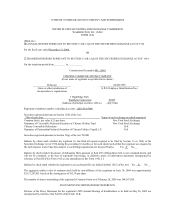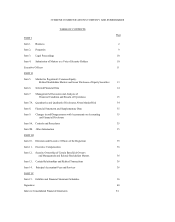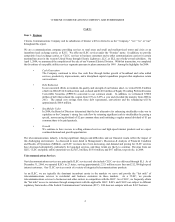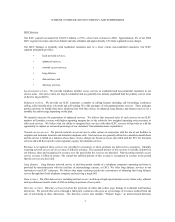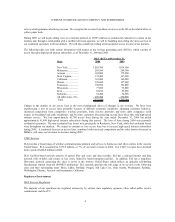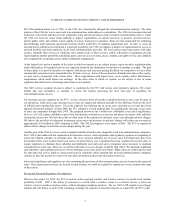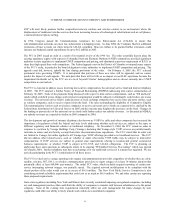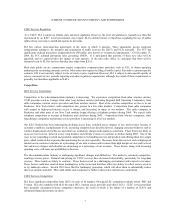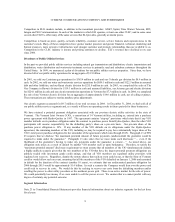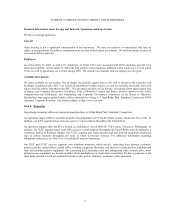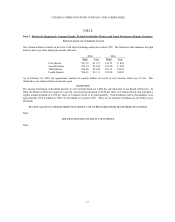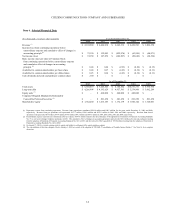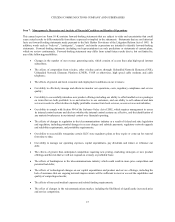Frontier Communications 2004 Annual Report Download - page 7
Download and view the complete annual report
Please find page 7 of the 2004 Frontier Communications annual report below. You can navigate through the pages in the report by either clicking on the pages listed below, or by using the keyword search tool below to find specific information within the annual report.
CITIZENS COMMUNICATIONS COMPANY AND SUBSIDIARIES
5
The Telecommunications Act of 1996, or the 1996 Act, dramatically changed the telecommunications industry. The main
purpose of the 1996 Act was to open local telecommunications marketplaces to competition. The 1996 Act preempts state and
local laws to the extent that they prevent competitive entry into the provision of any switched communications service. Under
the 1996 Act, however, states retain authority to impose requirements on carriers necessary to preserve universal service,
protect public safety and welfare, ensure quality of service and protect consumers. States are also responsible for mediating
and arbitrating interconnection agreements between CLECs and ILECs if voluntary negotiations fail. In order to create an
environment in which local competition is a practical possibility, the 1996 Act imposes a number of requirements for access to
network facilities and interconnection on all local communications providers. All local carriers must interconnect with other
carriers, unbundle their services at wholesale rates, permit resale of their services, enable collocation of equipment, provide
local telephone number portability and dialing parity, provide access to poles, ducts, conduits, and rights-of-way, and complete
calls originated by competing carriers under termination arrangements.
At the federal level and in a number of the states in which we operate we are subject to price cap or incentive regulation plans
under which prices for regulated services are capped in return for the elimination or relaxation of earnings oversight. The goal
of these plans is to provide incentives to improve efficiencies and increased pricing flexibility for competitive services while
ensuring that customers receive reasonable rates for basic services. Some of these plans have limited terms and, as they expire,
we may need to renegotiate with various states. These negotiations could impact rates, service quality and/or infrastructure
requirements which could impact our earnings. In the other states in which we operate, we are subject to rate of return
regulation that limits levels of earnings and returns on investments.
Our ILEC services segment revenue is subject to regulation by the FCC and various state regulatory agencies. We expect
federal and state lawmakers to continue to review the statutes governing the level and type of regulation for
telecommunications services.
For interstate services regulated by the FCC, we have elected a form of incentive regulation known as price caps for most of
our operations. Under price caps, interstate access rates are capped and adjusted annually by the difference between the level
of inflation and a productivity factor. Given the relatively low inflation rate in recent years, interstate access rates have been
adjusted downward annually. In May 2000, the FCC adopted a revised methodology for regulating the interstate access rates
of price cap companies through May 2005. The program, known as the Coalition for Affordable Local and Long Distance
Services, or CALLS plan, establishes a price floor for interstate-switched access services and phases out many of the subsidies
in interstate access rates. We have been able to offset some of the reduction in interstate access rates through end-user charges.
We believe the net effect of reductions in interstate access rates and increases in end-user charges will reduce our revenues by
approximately $4.0 million in 2005 compared to 2004. The CALLS program is set to expire in 2005. The FCC is expected to
address future changes in interstate access charges during the year.
Another goal of the 1996 Act was to remove implicit subsidies from the rates charged by local telecommunications companies.
The CALLS plan addressed this requirement for interstate services. State legislatures and regulatory agencies are beginning to
reduce the implicit subsidies in intrastate rates. The most common subsidies are in access rates that historically have been
priced above their costs to allow basic local rates to be priced below cost. Legislation has been considered in several states to
require regulators to eliminate these subsidies and implement state universal service programs where necessary to maintain
reasonable basic local rates. However, not all the reductions in access charges would be fully offset. We anticipate additional
state legislative and regulatory pressure to lower intrastate access rates in the near future. Many states are embracing the need
for state universal service funds to ensure protection for customers while ensuring that local telecommunications companies
continue to have the incentive to recover in rates their investment in their networks and new services.
Some state legislatures and regulators are also examining the provision of telecommunications services to previously unserved
areas. Since many unserved areas are located in rural markets, we could be required to expand our service territory into some
of these areas.
Recent and Potential Regulatory Developments
Effective November 24, 2003, the FCC issued an order requiring wireline and wireless carriers to provide local number
portability (LNP). LNP is the ability of customers to switch from a wireline carrier to a wireless carrier, or from one
wireless carrier to another wireless carrier, without changing telephone numbers. We are 100% LNP capable in our largest
markets and will deploy in each of the remaining exchanges in response to bona fide requests as required by the FCC order.

